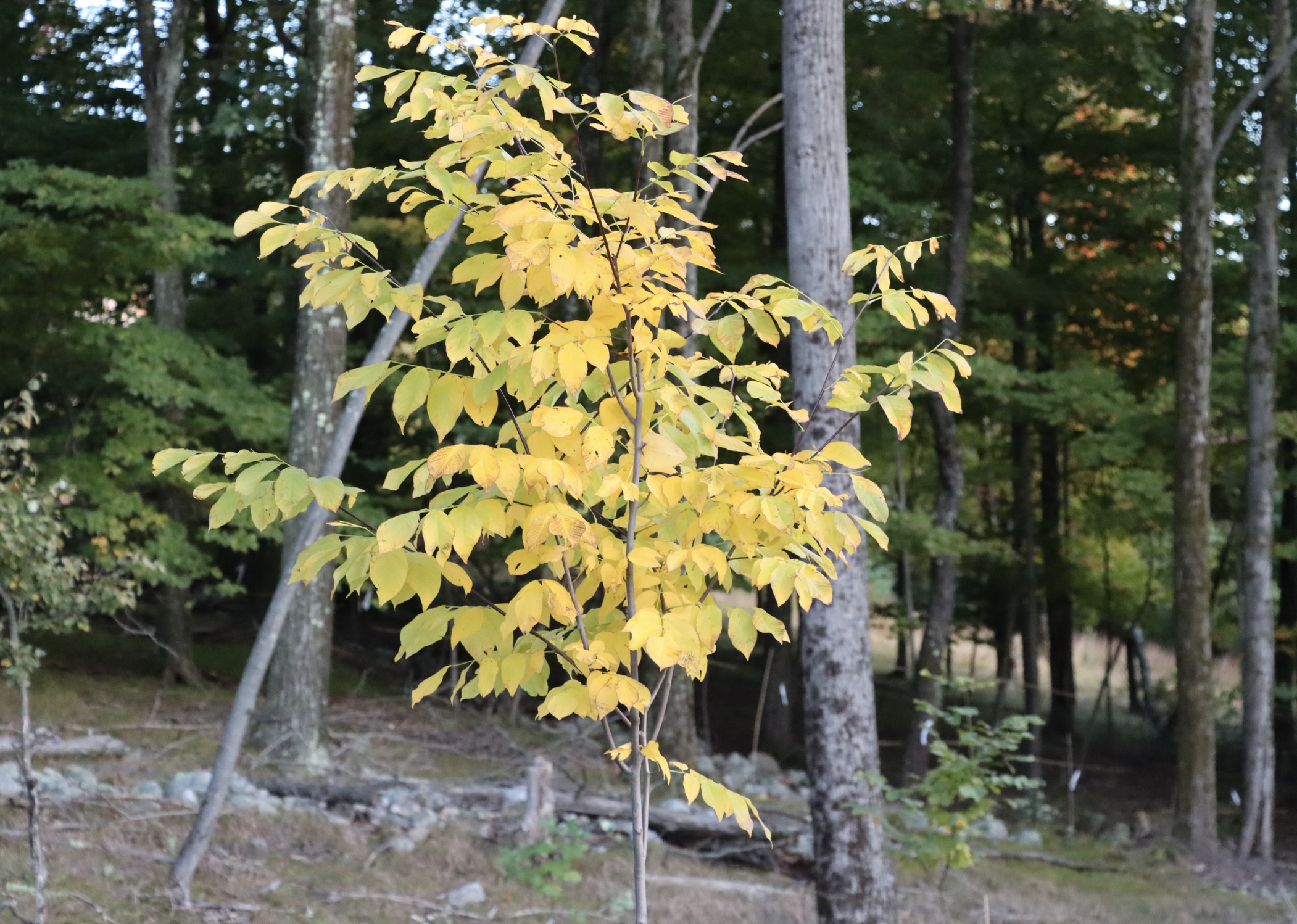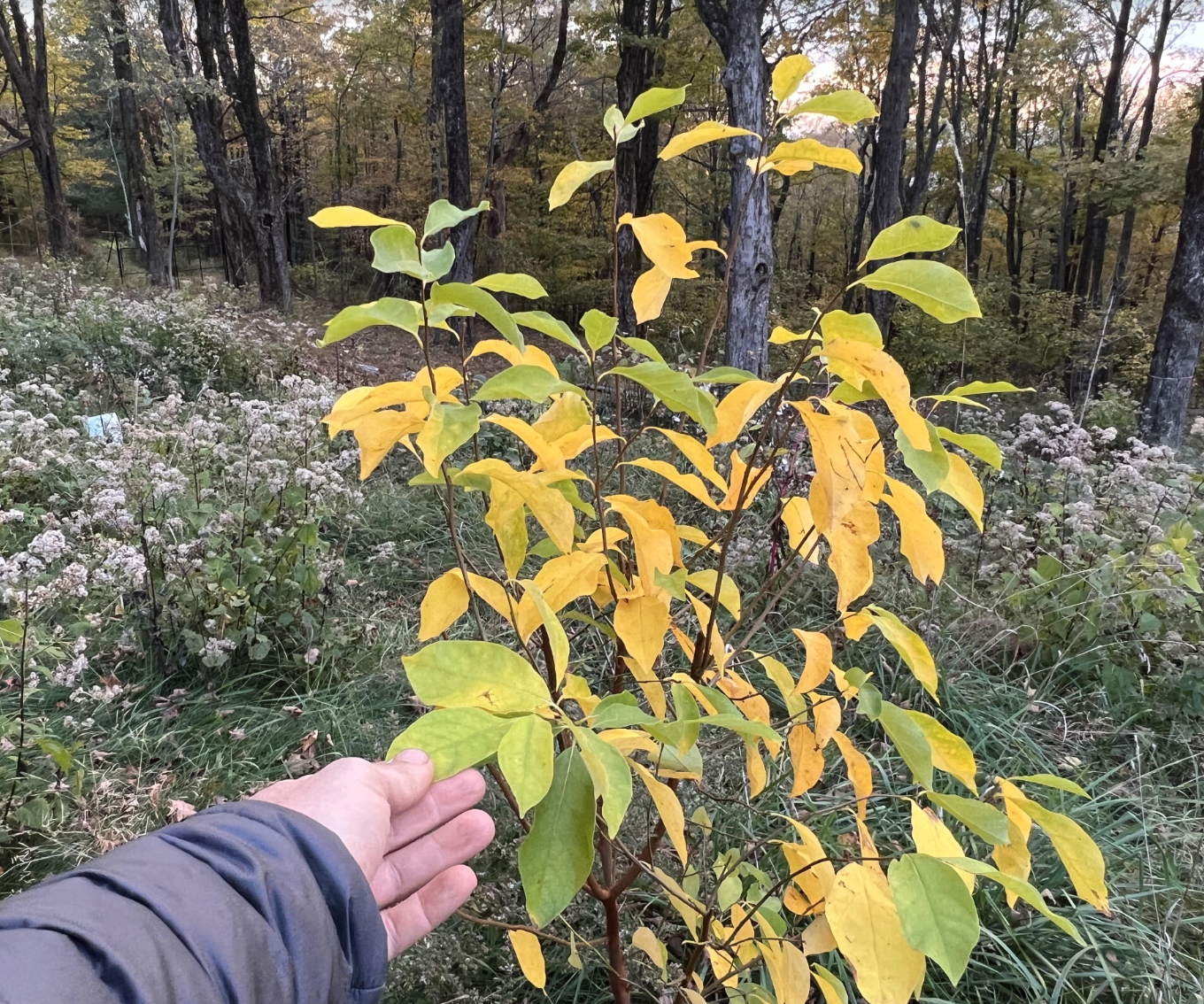NATIVE TREES AND SHRUBS FOR FANTASTIC *Yellow FALL FOLIAGE
by Mackenzie Younger
Young Yellowwood tree | Cladrastis kentukea | The New York Flower Farm, Ellenville, NY
Yellowwood
While the American yellowwood (Cladrastis kentukea) is rare in the wild (endemic to the southern Appalachian mountains) it is common in the landscaping industry, making it available to many people who desire a beautiful, medium-sized specimen tree.
In the fall yellowwood turns vivid yellow and really stands out amongst other trees. On top of the autumnal qualities of yellowwood, the tree flowers and has smooth grey bark (beech-tree-like in resemblance). Every part of this yellowwood is ornamental, and for that reason, it makes the top of the list.
When the yellowwood tree flowers in late spring / early summer, it will produce hanging structures of white, fragrant blossoms. These flowers dangle from the tree in the most graceful manner, blowing in the wind and dropping thousands of white peddles onto the ground below like confetti. It’s a truly magical display that makes for a memorable garden experience. Pollinators and people flock to this bonanza when it occurs.
We recommend planting yellowwood as a specimen tree in full sun or in a woodland composition. Consider placing this tree in a location where the flowers can be appreciated. And, as a way to enhance the yellow fall foliage, place it in front of dark evergreens.
Spicebush | Lindera benzoin | The New York Flower Farm, Ellenville, NY
2. Spicebush
Spicebush (Lindera benzoin) is probably best known for being the host plant of the spicebush butterfly. This common woodland species has grown popular in the landscaping community for both its ecological and ornamental qualities. Come fall spicebush explodes into hues of yellow often outperforming other shrubs in this color category. It’s a great plant to have in a composition with other shrubs and trees that turn red or orange. Even as a stand-alone, you will really appreciate the bright yellow display spicebush brings to your garden.
We love to use spicebush in the landscape because of these aesthetic attributes and its ability to attract and support local spicebush butterfly populations. Female plants will also produce red berries which songbirds flock to. Unfortunately, it’s hard to find nurseries that have the plants sexed because the female plant is the superior wildlife choice.
It's not just spicebushes fall foliage that is yellow but also its flowers that emerge in very early spring. Spicebush is the third native plant to bloom in the spring after pussy willow and red maple.
When it comes to selecting a space in the garden for spicebush, it does very well in shade but can also be planted in full sun if given lots of moisture and mulch. The more sun it gets the brighter the fall foliage will be, although part shade seems to be the sweet spot.
3. American Larch
The American L:arch (Larix laricina) is a true cold climate species. A tree most people never experience unless they live in our Northern states. This is unfortunate because Larch is majestic in so many ways.
In the autumn the tree flushes bright yellow after all the other trees have lost their leaves making it the ‘last act’ of fall color before winter sets in. This yellow is especially exceptional when contrasted with dark evergreens such as spruce, pine, and fir.
Unlike most conifers, larch is deciduous and will lose its needle after it turns yellow. There are only two groups of native, deciduous conifers in the Eastern United States, the American Larch, and the cypresses, bald cypress, and pond cypress; the irony is they exist in polar opposite regions, the American Larch in the far north and the bald cypress in the deep south.
We recommend larch to anyone in a colder climate down to zone 6. What it wants more than anything else is full sun. Wet sites are appreciated (think bog) but it can also do fine in average soil if amended with organic material and acidifier (lots of much helps too).
Larch is a whimsical tree, a ‘Dr. Seuss Christmas tree’ of the imagination, with its soft needles and elegant branches. Because it's literally the last tree to turn color in the fall, yellow color, it's high on this list.
4. Birches
The birch family (Betulaceae) is a diverse group of trees famous for their bark and yellow fall foliage. Below is a list of our native birches. Where and how best to use them.
Paper Birch (Betula papyrifera) is probably the most iconic birch out of all the trees. It has clean white bark that peels away from the tree and was once used to line canoes. Visitors to North Woods often take sleeves of paper birch bark from this tree as souvenirs, peeling them directly from the tree which is unfortunately detrimental to the tree’s health. The bark should only be collected from dead trees on the ground. Like American larch, paper birch is a cold climate tree with a limited tolerance to heat and drought, so while it's the most iconic of the birches, it's also the hardest to use in the landscape for most gardeners.
If you live in a cold state or in the mountains, paper birch is a wonderful option. We suggest planting paper birch in front of evergreens to increase the visual impact of its white bark and gold fall foliage. They need full sun, and their roots prefer cool and moist soil. Consider adding lots of mulch, weed fabric, or even rocks to keep that soil protected around the base of the tree.
Yellow Birch (Betula alleghaniensis) is another northern species, although it can be found growing along the Appalachian mountains at higher elevations and way down into states like Tennessee and North Carolina. Like Paper birch, it's really only recommended for gardeners in somewhat cooler climates, although if protected from drought, it's worth a try in transitional zones (climate zone 7).
Yellow birch has a really unique metallic-looking bark with a golden tinge and brilliant golden-yellow fall foliage. This tree is far more shade tolerant than most other birches and in the wild, often starts its life under the canopy of a forest, rather than in disturbance events (fire, farming, flood) like the other sun-loving birches on this list.
Yellow birch gets quite large and makes for a really fun specimen tree. It can also be used as a bonsai because of its ability to germinate on rotten logs or even rocks that have accumulated moss. As the tree matures, the roots will grow right over these objects making for a really enchanting plant specimen.
Black Birch (Betula lenta) is a much different-looking birch from the others on this list. As the name suggests, it has black-in-color bark, which starts smooth and over time gets blocky. This is a transitional zone birch, inhabiting forests from New England down into the central south and midwest, handling much hotter humid summers. Black birch was once used to make birch beer, and if you break off a tiny tip from one of its branches, you can smell and taste that iconic flavor. Although the bark is less showy, black birch may have the best golden-yellow fall foliage out of all the birches and is often the first to flush colors in the fall. And for this reason, it stands out amongst other trees.
Although less common in the landscaping industry — we highly suggest using black birch in climates where paper birch and yellow birch have trouble growing.
Grey Birch (Betula populifolia) resembles paper birch but unlike paper birch, it can handle dry areas. While its bark can be greyish in color, it can also be a beautiful white and is often mistaken for paper birch in the wild.
Grey birch is the smallest of the birch trees and is a wonderful option for gardens with limited space. In the fall grey birch turns a pleasant yellow, often later than other trees.
We recommend using the cultivar ‘Whitespire’ because it is very consistent in having a bright white bark. Given its size try pairing this beautiful tree with small flowering trees like dogwoods and redbuds.
River Birch (Betula nigra) is the most widely used birch in the landscaping industry.
Want a birch but live in a hot, humid climate? Well, this is the tree for you. River birch is our most southern species of birch. That said, the hotter it gets the more water it needs and in the wild, you'll find it living along rivers and streams.
River birch is a great option for yellow fall foliage in warmer climates. We recommend planting it with red maples and other specimen trees because it does get big.
This tree is especially beautiful when it's young but as it gets older, the highly aesthetic, white and pink in colored, peelig bark, actually turns black. Mature river birches look nothing like their young version. That said, it's a fantastic landscape tree far more adaptable than many of the other birches and you’ll be happy to have it in your landscape!
Sweet pepperbush | Clethra alnifolia | Boothbay, ME
5. Sweet pepperbush
Sweet pepperbush (Clethra alnifolia) is a wonderful native shrub that can be incorporated into anyones landscape. It’s a late-season bloomer (July / August) with fragrant flowers that are highly attractive to both people and pollinators. In the fall sweet pepperbush turns brilliant hues of golden yellow which will light up your garden.
In the wild sweet pepperbush occupies acidic coastal forests and wetlands but is highly adaptable in the garden taking both full sun and part shade. We recommend adding some compost and bark mulch to your soil mix to replicate its natural growing conditions.
Because of its ability to fit into most gardens, its wonderful, yellow falls foliage, and its fragrant, highly attractive flowers for pollinators; sweet pepperbush is an awesome landscape choice.
6. Bottlebrush Buckeye
Bottlebrush buckeye (Aesculus parviflora) like sweet pepperbush is a late-season bloomer that pollinators adore, especially our large swallowtail butterflies. In the fall it too becomes electric with yellow foliage and is one of the best shrubs for such a display. Unlike our other native buckeyes which grow as trees, bottlebrush buckeye is a large ‘mushrooming’ shrub (in shape) that will slowly expand outwards.
Unlike sweet pepperbush which fits nicely into small spaces, bottlebrush buckeye is better for a larger landscape as a lawn specimen or within a woodland composition under large trees.
Bottlebrush buckeye can be grown in full sun and part shade. It wants to stay moist so mulch around its roots. Once established it can handle most situations and will be a wonderful addition to any garden.
All the yellow trees are Tulip Poplar | Liriodendron tulipifera | Shawangunk Mountains, NY
7. Tulip Poplar
Tulip Poplar (Liriodendron tulipifera) is named ‘tulip’ because its flowers resemble the tulip flower and polar because of its fast-growth rate, like poplar trees. If I could choose a common name, it would be ‘flower tower’ since the tulip poplar is the second tallest native tree in the eastern United States, barely beaten out by the white pine. This can be a massive tree at maturity and one of the most impressive in old-growth forest specimens along the Appalachian mountains and in old cemeteries and parks.
When it comes to yellow foliage, the tulip poplar excels and is often the last tree to produce color in the fall.
We recommend using tulip poplar in large landscapes, either as a lawn specimen tree or in combination with other large trees in a forest-like setting. That said, it requires lots of sun to survive and will grow tall and straight rapidly in forest openings. Try planting tulip poplar with sugar maple, red maple, and scarlet oak for an exciting mix of fall colors.
Quaking apsen | Populus tremuloides | Ellenville, NY
Quaking apsen | Populus tremuloides | Ellenville, NY
8. Quaking aspen
Quaking aspen (Populus tremuloides) is probably one of the most famous trees for yellow fall foliage and would be higher on this list if it was more consistent, at least in the regions where most people live. That said, if you live in the high mountains or northern states where late fall / early winter can come fast and furious, with really cold nights — then quaking aspen is a great option and will perform wonderfully in the fall!
We recommend planting quaking aspen in front of dark evergreens or in groups as one would see them in the wild. Their quaking leaves act as natural wind chimes, creating a soundscape for your garden that can be enchanting.
9. Hickories
There are 18 species of hickory world wide and out of the 18, 15 of them are native to the United States. This means if you want to experience hickories — America is the place to be!
While this is a diverse and beautiful group of trees, hickories are extremely rare in the nursery trade and for that reason, they are often only experienced where they naturally occur vs in planted and designed landscapes. This is a shame because all hickories produce gorgeous deep gold fall foliage and can make for wonderful specimen trees.
We recommend protecting hickory trees that might naturally occur on your property because of their natural beauty and wildlife benefits. If you really want to plant a hickory, they can be found online or at a specialty nursery. They are to find but it can be done.
Hickories are great for attracting wildlife and should be used in food plots and habitat restoration projects.
PawPaw | Asimina triloba | Boothbay, ME
10. Paw Paw
Last one on our list (although there are so many great native plants for yellow fall foliage) is pawpaw (Asimina triloba). Pawpaw is a really unique North American tree that produces tropical fruit the size of a mango! These fruit taste somewhat like banana and mango custard and was much more popular in colonial times. Because the fruit has a short shelf life and so pawpaws never become commercially viable.
On top of the exotic fruit pawpaw produce, the tree has delightful yellow fall foliage. We recommend using pawpaw as a fun addition to any edible landscape or native garden. They like moist, rich soil and can grow out of compost piles.
Pawpaws naturally occur in forest-like settings, but the more sun you give them, the more fruit you will get. It’s recommended to plant more than one for cross-pollination.
Fun fact: Pawpaw is the only host plant of the zebra swallowtail Butterfly. While the common pawpaw (Asimina triloba) can be found throughout the south and midwest, Florida is home to several other species of pawpaw, which are very rare and almost never found in the landscaping industry.
More great choices for yellow fall foliage include:
Catalpa (often a beautiful lime yellow)
Honey Locust (bright yellow)
American Beech (more bronze)
Witch-hazel (bright yellow)
Amsonia (perennail) (bright yellow)
Northern Catapla | Catalpa speciosa | Wallkill, NY
Witch-hazel | Hamamelis virginiana
Honey Locust | Gleditsia triacanthos | Hudson, NY










